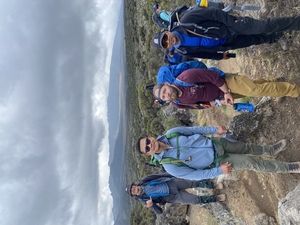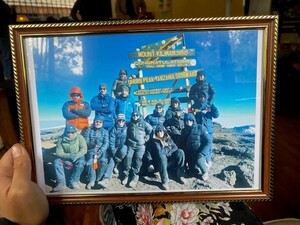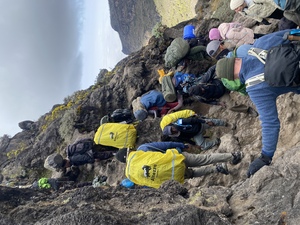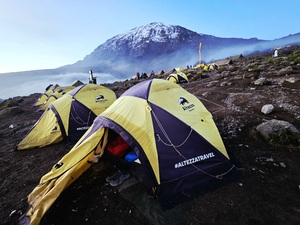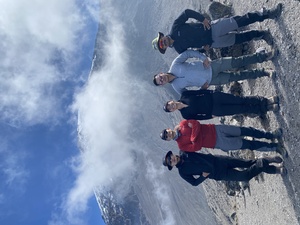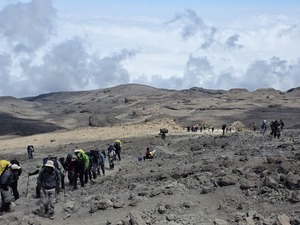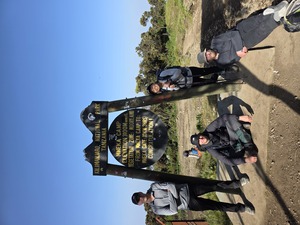Summiting the roof of Africa – Two Reflections.
THE FIRST VIEW
Fourteen adventurers recently completed what many described as the most transformative experience of their lives, successfully reaching the 19,341-foot summit of Mount Kilimanjaro via the challenging seven-day Lemosho Route. Led by two mountain leaders and supported by six experienced local guides, the entire group achieved the remarkable feat of reaching Uhuru Peak on Tanzania’s iconic mountain.
This was undertaken by a team from 1 Signal Brigade, and included three reservists, three full-time British soldiers, and eight Gurkhas from the British Army. Kilimanjaro holds a somewhat legendary status. It is the highest freestanding mountain in the world, and for that reason, it is classed as the tallest, although not the highest overall. After over sixty applications, the team was selected to reflect a diverse range of ranks and backgrounds. The Ulysses Trust was extremely generous in supporting this mission, helping the three titular reservists achieve something extraordinary before returning to their everyday lives and day jobs with a heck of a story to tell.
Preparing for the Ultimate Test
The expedition required an immense amount of logistical planning and physical preparation. Physical training sessions in Wales pushed participants beyond their comfort zones, with weekend training sessions in participants’ units. These preparatory climbs revealed individual strengths and weaknesses, allowing the team to develop support strategies that would prove vital on Kilimanjaro. It was also essential for team cohesion, as we were fourteen individuals from a range of backgrounds living all over the UK, from Gloucester to Aberdeen!
Day 1: To Shira 1 Camp. The team was dropped off at 3,400m and enjoyed a short, pleasant walk to our first camp, Shira 1. This only took a couple of hours, and we were introduced to the Kilimanjaro mantra of ‘Poli Poli’, meaning ‘slowly slowly’ in Swahili. This was a good shake-out opportunity to chat with the local guides and integrate with a stunning view of Uhuru Peak ahead of us. The landscape transformed into rolling hills dotted with giant heather and unique alpine plants. The team reached Shira 1 Camp at 3,610 meters.
Day 2: Shira 1 Camp to Shira 2 Camp. This acclimatisation day covered 7 kilometres across the vast Shira Plateau, providing additional altitude exposure. The relatively short distance allowed the team to explore the plateau’s unique geological features, including ancient lava formations and the remains of Kilimanjaro’s collapsed western crater rim. The day ended at Shira 2 Camp (3,850 meters), with moderate elevation gain helping the acclimatisation process. We ventured out on a short acclimatisation hike, gaining another 200m of ascent, which allowed us to adapt to the thinner air. By this time, people had begun to feel the effects of higher altitude, and some of the team were using Diamox to help.
Day 3: Shira 2 Camp to Barranco Camp via Lava Tower. The longest day covered 10 kilometres over eight hours, following the critical “climb high, sleep low” principle. The route ascended to Lava Tower (4,630 meters) for lunch, gaining nearly 800 meters in elevation before descending through the dramatic Barranco Valley. This challenging day tested the team’s resolve as altitude effects became more pronounced, but the descent to Barranco Camp (3,960 meters) provided relief and stunning views of the Southern Glaciers. Several of the team were now showing several symptoms of acute mountain sickness (AMS), but the local guides were fantastic in their regular check-ups and medical care.
Day 4: Barranco Camp to Karanga Camp The day began with the infamous Barranco Wall, a steep rocky scramble requiring basic climbing techniques over 257 meters of vertical gain. The 5-kilometer trek continued through alpine desert terrain to Karanga Camp (3,995 meters). Despite the short distance, the technical nature of the Barranco Wall and continued altitude exposure made this a mentally and physically demanding day.
Day 5: Karanga Camp to Barafu Camp Summit preparation day covered 4 kilometers to Barafu Camp (4,673 meters), the launch point for the final summit push. The stark, lunar-like landscape offered little vegetation as the team entered the alpine desert zone. After establishing camp, climbers rested during the afternoon before an early dinner and attempted sleep before the very early summit departure.
Day 6: Summit Day – Barafu Camp to Uhuru Peak to Mweka Camp The ultimate challenge began at midnight, covering 5 kilometres and 1,345 meters of elevation gain to reach Uhuru Peak (5,895 meters) at sunrise. The gruelling seven-hour ascent through loose scree and freezing temperatures tested every ounce of determination. This was mainly undertaken in the dark, as we began at 11am. The sun only rose for the final couple of hours. Many of us had climbed that elevation gain in a day, some of us even far more, but the effects of doing it at 5,000m with low air pressure were truly immense. This was physically difficult but mentally cumbersome, truly pushing individuals in all areas that AT is designed to, and we were well out of our comfort zone. The feeling of the summit was truly like no other. We had views of a cloud blanket for miles, with the mountain rising up from its head above the crowd. We had never truly felt free until that moment. It was just a shame there was a queue of some twenty Americans for a summit photo! After summit celebrations and photographs, the team descended 12 kilometres to Mweka Camp (3,100 meters), losing over 2,700 meters in elevation during an exhausting but triumphant final day, before completing the final 10-kilometre descent to Mweka Gate the following morning.
Building Tomorrow’s Leaders
The expedition’s leadership development impact exceeded all expectations. Participants naturally assumed leadership roles during different phases of the climb, with those experiencing difficulties on certain days being supported by teammates who then looked to them for guidance when roles were reversed.
For Zak, aged 23, the Kilimanjaro expedition represented his first opportunity to apply his mountain leader qualification in an international setting. The young soldier found himself tested in ways his training had prepared him for, yet still presented unique challenges that pushed his leadership abilities to new levels. Managing a diverse group of fourteen climbers through altitude sickness, extreme weather conditions, and the psychological demands of the seven-day ascent required him to adapt his military leadership training to a civilian expedition environment. “Leading people up Kilimanjaro taught me that real leadership isn’t about giving orders, it’s about reading each person’s needs, knowing when to push them forward and when to slow down, and making sure everyone feels supported even when you’re struggling yourself.”
Measuring True Success
While reaching Uhuru Peak represented a significant achievement, the expedition’s real success lies in the measurable changes in participants’ confidence, leadership abilities, and life trajectories. Post-expedition assessments revealed increased confidence levels across all participants, with particularly dramatic improvements among those from disadvantaged backgrounds and veterans transitioning to civilian life.
The expedition demonstrated that adventurous training, properly planned and executed, creates lasting positive change that extends far beyond the mountain. Participants returned as confident leaders, supportive teammates, and individuals equipped with unshakeable self-belief.
Legacy and Continuation
This expedition has established a foundation for continued character development and leadership training. The bonds forged on Kilimanjaro have created a support network that continues to challenge and encourage participants in their ongoing personal development.
The success of this expedition, particularly in transforming participants from diverse backgrounds, including Gurkhas, mechanics, and even a university student, demonstrates the profound impact that carefully planned adventurous training can achieve. The mountain served as both a classroom and a testing ground, producing confident, capable leaders equipped to make positive contributions to their communities and careers.
A SECOND VIEW
Ex WYVERN UHURU STRIKE 25 Expedition, named after Uhuru Peak – the highest point on Mount Kilimanjaro at 5,895 meters – aimed to safely summit the mountain as a team. Fourteen volunteers from 1 Signal Brigade took part, faced one of the most challenging adventure training exercises of their career. For all of us, excitingly, it was our highest altitude climb.
After flying from Manchester, we were welcomed by Altezza Travel and taken to their hotel for admin checks before the climb. Preparations included equipment checks and a shakeout hike in Materuni village. This short excursion included a visit to a local waterfall and a tour of a coffee-producing village, where the team was introduced to Tanzanian singing and hospitality. The comfort of a bed and a toilet lasted for only two nights before we embarked on a 7-days expedition into the mountain.
Day 1 began from an elevation of 3,200 metres on the Shira Plateau. The following day involved a relatively short trek, offering panoramic views of the plateau and the snow-capped peaks of Kilimanjaro in the distance and we camped at Shira Camp 2; allowing time for acclimatisation. The challenge intensified on the 3rd day as we made our way to Lava Tower—the second highest elevation point before the final summit attempt. It was at this stage that the effects of Acute Mountain Sickness (AMS) began to manifest among us. Symptoms included headaches and nausea; I suffered from headache and vomiting but was treated by the medical team. Subsequently, we camped at Karanga and Barafu camp ensuring that the team were acclimatising as much as possible before the summit.
The summit push began on the 5th day at 2330hrs after dinner, with sleep deprivation and AMS testing more team members’ performance. The guides’ singing played a significant role in motivating us and the constant support from each one of us was crucial in keeping us focused. I, in particular, faced considerable challenges throughout this period. My expedition leader’s concern was both reassuring and motivating and his words — “Safety is my priority. If I must send you back to camp, don’t be disheartened”— helped me regain composure more effectively than supplemental oxygen could. From that point onward, I continued moving forward, albeit at a deliberately slow pace. Despite the challenges we faced, we summited just after sunrise, embodying the chant we’ve been singing since day 1, “One team, one dream. Nonstop, to the top.”
This expedition highlighted the strength of mental resilience, teamwork, and personal growth. Returning to our units, we carried newfound confidence and determination inspired by our peers.
We would like to extend our gratitude to Ulysses Trust for their grant. In the spirit of paying forward the support we received, our team successfully raised over £1,000 to contribute toward the education of students at a local school in Moshi. The funds were used to procure essential school supplies, which were carefully selected and personally delivered to the students. This outreach culminated in a day of engagement and community-building activities, including friendly games of football and dodgeball.
Through this experience, the value and purpose of the Ulysses Trust’s mission became abundantly clear. The opportunity to give back and witness the direct impact of our efforts was profoundly rewarding, reinforcing the importance of such charitable support.
A framed photo taken at Uhuru Peak was gifted to the school as a symbol of perseverance and teamwork, reminding all that with support, even the toughest goals can be achieved.
-Sig Sioson from 39 Signal Regiment

